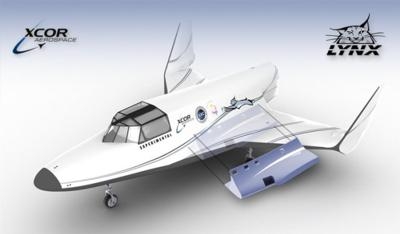Thu, Sep 13, 2012
Critical Component Designed For 'Tens Of Thousands' Of Flights
XCOR Aerospace announced Tuesday that the Lynx Mark I suborbital reusable launch vehicle (RLV) wing strake assemblies will be manufactured by FiberDyne Advanced Composites of Tukwila, WA. The Lynx wing strakes are critical structural components that attach the Lynx fuselage to the wings and hold kerosene fuel, attachment points for the main landing gear, and bays for the vehicle's reaction control thrusters.

The strakes have been designed by XCOR to rigorous design standards that will enable a craft to perform tens of thousands of flights to and from suborbital altitudes exceeding 100 kilometers. The strake has undergone an iterative design process by XCOR engineers and outside independent third party structural and thermal analysis experts from Quartus Engineering in San Diego.
FiberDyne was selected after a thorough competitive selection process that emphasized past experience, ability to manufacture complex carbon fiber structures used in safety critical pressurized applications, schedule and value. FiberDyne is teamed with tool maker Sierra Technical Services of Mojave, CA. “FiberDyne really stepped up for us with the wing strakes,” said Jeff Greason, Co-Founder and President of XCOR, “we are asking a lot in terms of performance and schedule from their team, and we’ve been impressed thus far with the results. It is very exciting to see our designs we’ve worked on for so many years coming to life before us.”
“FiberDyne is proud and honored to have been selected as a primary supplier for XCOR,” said Steven Zack, Founder and President of FiberDyne, “with our sights set on the future growth and success of XCOR Lynx program and private space development as a whole. Our motto at FiberDyne is Lighter, Faster, and Stronger… All of which will be applied to the Lynx program. ”
The wing strakes will be installed on the Lynx Mark I which is the prototype of the Lynx family of suborbital RLVs from XCOR. All Lynx vehicles will be able to seat an astronaut pilot and a single spaceflight participant, or an astronaut pilot and large scientific payload. The "Lynx Mark II" is the designated name for the Lynx production model and is designed to fly to space up to four times per day with similar payload as the Lynx Mark I but with significantly improved performance.
XCOR has already announced Lynx Mark II wet lease agreements with emerging space lines. XCOR has already announced the signing of a wet lease definitive agreement for Lynx Mark II operations in the island nation of Curacao and plans for XCOR-led operations at two U.S. sites, Mojave, California and Kennedy Space Center Shuttle Landing Facility in Florida, pending final NASA approvals.
(Image provided by XCOR)
More News
Aero Linx: International Federation of Airworthiness (IFA) We aim to be the most internationally respected independent authority on the subject of Airworthiness. IFA uniquely combi>[...]
Ultrahigh Frequency (UHF) The frequency band between 300 and 3,000 MHz. The bank of radio frequencies used for military air/ground voice communications. In some instances this may >[...]
A Few Questions AND Answers To Help You Get MORE Out of ANN! 1) I forgot my password. How do I find it? 1) Easy... click here and give us your e-mail address--we'll send it to you >[...]
From 2019 (YouTube Edition): Learning To Paint Without Getting Any On Your Hands PPG's Aerospace Coatings Academy is a tool designed to teach everything one needs to know about all>[...]
Also: Sustainable Aircraft Test Put Aside, More Falcon 9 Ops, Wyoming ANG Rescue, Oreo Cookie Into Orbit Joby Aviation has reason to celebrate, recently completing its first full t>[...]
 ANN's Daily Aero-Linx (05.06.25)
ANN's Daily Aero-Linx (05.06.25) ANN's Daily Aero-Term (05.06.25): Ultrahigh Frequency (UHF)
ANN's Daily Aero-Term (05.06.25): Ultrahigh Frequency (UHF) ANN FAQ: Q&A 101
ANN FAQ: Q&A 101 Classic Aero-TV: Virtual Reality Painting--PPG Leverages Technology for Training
Classic Aero-TV: Virtual Reality Painting--PPG Leverages Technology for Training Airborne 05.02.25: Joby Crewed Milestone, Diamond Club, Canadian Pilot Insurance
Airborne 05.02.25: Joby Crewed Milestone, Diamond Club, Canadian Pilot Insurance



